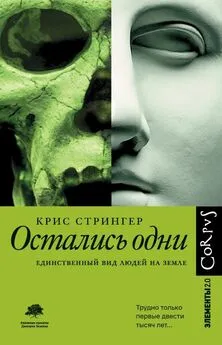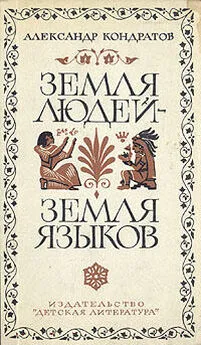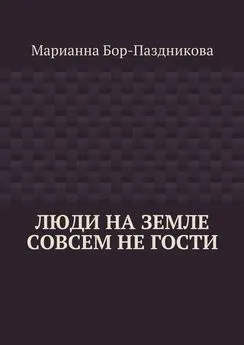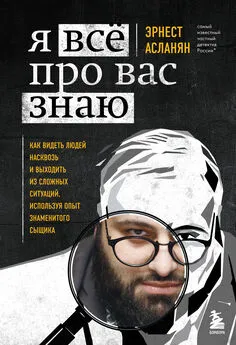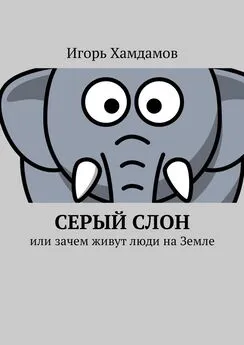Крис Стрингер - Остались одни. Единственный вид людей на земле
- Название:Остались одни. Единственный вид людей на земле
- Автор:
- Жанр:
- Издательство:Литагент Corpus
- Год:2021
- Город:Москва
- ISBN:978-5-17-982912-6
- Рейтинг:
- Избранное:Добавить в избранное
-
Отзывы:
-
Ваша оценка:
Крис Стрингер - Остались одни. Единственный вид людей на земле краткое содержание
Один из ведущих мировых специалистов, британский антрополог Крис Стрингер, тщательно собирает гигантский пазл, чтобы показать нам цельную картину: что на сегодняшний день известно науке о нас и о других представителях рода Homo, чего мы достигли в изучении своего эволюционного пути и куда движемся по нему дальше.
В формате PDF A4 сохранён издательский дизайн.
Остались одни. Единственный вид людей на земле - читать онлайн бесплатно ознакомительный отрывок
Интервал:
Закладка:
N. A. Drake, R. M. Blench, S. J. Armitage, C. S. Bristow, K. H. White. “Ancient watercourses and biogeography of the Sahara explain the peopling of the desert”. Proceedings of the National Academy of Sciences USA 108. 2011, 458–462.
A. Gibbons. “Palaeontologists get X-ray vision”. Science 318. 2007, 1546–1547.
K. Harvati, S. R. Frost, K. P. McNulty. “Neanderthal taxonomy reconsidered: Implications of 3D primate models of intra- and interspecific differences”. Proceedings of the National Academy of Sciences USA 101. 2004, 1147–1152.
S. Hillson, S. Parfitt, S. Bello, M. Roberts, C. Stringer. “Two hominin incisor teeth from the Middle Pleistocene site of Boxgrove, Sussex, England”. Journal of Human Evolution 59. 2010, 493–503.
J. D. Irish, D. Guatelli-Steinberg. “Ancient teeth and modern human origins: An expanded comparison of African Plio-Pleistocene and recent world dental samples”. Journal of Human Evolution 45. 2003, 113–144.
M. Martinon-Torres, J. M. Bermudez de Castro, A. Gomez- Robles, J.-L. Arsuaga, E. Carbonell, D. Lordkipanidze, G. Manzi, A. Margvelashvili. “Dental evidence on the hominin dispersals during the Pleistocene”. Proceedings of the National Academy of Sciences USA 104. 2007, 13279–13282.
W. Muller, H. Fricke, A. N. Halliday, M. T. McCulloch, J. A. Wartho. “Origin and migration of the Alpine Iceman”. Science 302 (5646. 2003, 862–866.
M. S. Ponce de Leon, L. Golovanova, V. Doronichev, G. Romanova, T. Akazawa, O. Kondo, H. Ishida, C. P. Zollikofer. “Neanderthal brain size at birth provides insights into the evolution of human life history”. Proceedings of the National Academy of Sciences USA 105. 2008, 13764–13768.
M. S. Ponce de Leon, C. P. E. Zollikofer. “Neanderthal cranial ontogeny and its implications for late hominid diversity”. Nature 412. 2001, 534–538.
M. S. Ponce de Leon, C. P. E. Zollikofer, R. Martin, C. Stringer. “Investigation of Neanderthal morphology with computer-assisted methods”. In C. Stringer, R. N. Barton, C. Finlayson, eds. Neanderthals on the Edge: 150 th Anniversary Conference of the Forbes’ Quarry Discovery, Gibraltar , 237–248. Oxbow Books, Oxford, 2000.
M. P. Richards, E. Trinkaus. “Isotopic evidence for the diets of European Neanderthals and early modern humans”. Proceedings of the National Academy of Science USA 106. 2009, 16034–16039.
T. M. Smith, P. Tafforeau, D. J. Reid, R. Grun, S. Eggins, M. Boutakiout, J.-J. Hublin. “Earliest evidence of modern human life history in north African early Homo sapiens ”. Proceedings of the National Academy of Sciences USA 104. 2007, 6128–6133.
T. M. Smith, P. Tafforeau, D. J. Reid, J. Pouech, V. Lazzari, J. Zermeno, D. Guatelli-Steinberg, A. Olejniczak, A. Hoffmann, J. Radovčić, M. Makaremi, M. Toussaint, C. Stringer, J.-J. Hublin. “Dental evidence for ontogenetic differences between modern humans and Neanderthals”. Proceedings of the National Academy of Sciences USA 108. 2011, 8720–8724.
T. M. Smith, M. Toussaint, D. J. Reid, A. J. Olejniczak, J.-J. Hublin. “Rapid dental development in a Middle Paleolithic Belgian Neanderthal”. Proceedings of the National Academy of Sciences USA 104. 2007, 20220–22025.
F. Spoor, J.-J. Hublin, M. Braun, F. Zonneveld. “The bony labyrinth of Neanderthals”. Journal of Human Evolution 44. 2003, 141–165.
R. E. Stevens, R. Jacobi, M. Street, M. Germonpre, N. J. Conard, S. C. Munzel, R. E. M. Hedges. “Nitrogen isotope analyses of reindeer. Rangifer tarandus , 45,000 BP to 900 BP: Palaeoenvironmental reconstructions”. Palaeogeography, Palaeoclimatology, Palaeoecology 262. 1–2. 2008, 32–45.
C. B. Stringer, M. C. Dean, R. Martin. “A comparative study of cranial and dental development in a recent British sample and Neanderthals”. In C. J. DeRousseau, ed. Primate Life History and Evolution , 115–52. Liss, New York, 1990.
C. B. Stringer, L. Humphrey, T. Compton. “Cladistic analysis of dental traits in recent humans using a fossil outgroup”. Journal of Human Evolution 32. 1997, 389–402.
C. B. Stringer, E. Trinkaus, M. Roberts, S. Parfitt, R. Macphail. “The Middle Pleistocene human tibia from Boxgrove”. Journal of Human Evolution 34. 1998, 509–547.
C. Turner. “Microevolution of East Asian and European populations: A dental perspective”. In T. Akazawa, K. Aoki, T. Kimura, eds. The Evolution and Dispersal of Modern Humans in Asia , 415–38. Hokusen-Sha, Tokyo, 1992.
M. J. Walker, J. Ortega, K. Parmova, M. V. Lopez, E. Trinkaus. “Morphology, body proportions, and postcranial hypertrophy of a female Neandertal from the Sima de las Palomas, southeastern Spain”. Proceedings of the National Academy of Sciences USA 108. 2011, 10087–10091.
T. D. Weaver, J.-J Hublin. “Neandertal birth canal shape and the evolution of human childbirth”. Proceedings of the National Academy of Sciences USA 106. 2009, 8151–8156.
R. Ardrey. African Genesis . Atheneum, New York, 1961.
M. Balter. “Was North Africa the launch pad for modern human migrations?” Science 331. 2011, 20–23.
C. Bergman, C. B. Stringer. “Fifty years after: Egbert, an early Upper Palaeolithic juvenile from Ksar Akil, Lebanon”. Paleorient 15. 1990, 99–112.
J. M. Bermudez de Castro, M. Martinon-Torres, E. Carbonell, S. Sarmiento, A. Rosas, J. van der Made, M. Lozano. “The Atapuerca sites and their contribution to the knowledge of human evolution in Europe”. Evolutionary Anthropology 13. 2004, 11–24.
K. C. Bickart, C. I. Wright, R. J. Dautoff, B. C. Dickerson, L. Feldman Barrett. “Amygdala volume and social network size in humans”. Nature Neuroscience 468. 2010. doi:10.1038/nn.2724.
R. Bigelow. The Dawn Warriors: Man’s Evolution toward Peace . Little, Brown, Boston, 1969.
P. Brown, T. Sutikna, M. J. Morwood, R. P. Soejeno, E. Jatmiko, W. Saptomo, R. A. Due. “A new small-bodied hominin from the Late Pleistocene of Flores, Indonesia”. Nature 431. 2004, 1055–1061.
I. Crevecoeur, H. Rougier, F. Grine, A. Froment. “Modern human cranial diversity in the Late Pleistocene of Africa and Eurasia: Evidence from Nazlet Khater, Peştera cu Oase and Hofmeyr”. American Journal of Physical Anthropology 140. 2009, 347–358.
M. H. Day, C. B. Stringer. “Les restes craniens d’Omo-Kibish et leur classification a l’interieur du genre Homo ”. L’Anthropologie 94. 1991, 573–94.
R. Dennell, W. Roebroeks. “An Asian perspective on early human dispersal from Africa”. Nature 438. 2005, 1099–1104.
F. G. Fedele, B. Giaccio, I. Hajdas. “Timescales and cultural process at 40,000 BP in the light of the Campanian Ignimbrite eruption, Western Eurasia”. Journal of Human Evolution 55. 2008, 834–857.
L. V. Golovanova, V. B. Doronichev, N. E. Cleghorn, M. A. Koulkova, T. V. Sapelko, M. S. Shackley. “Significance of ecological factors in the Middle to Upper Paleolithic transition”. Current Anthropology 51 (5. 2010, 655–91.
K. Harvati, J.-J. Hublin. “Morphological continuity of the face in the late Middle and Upper Pleistocene hominins from northwestern Africa – a 3D geometric morphometric analysis”. In J.-J. Hublin, S. McPherron, eds. Modern Origins: A North African Perspective . Springer, Dordrecht, in press.
T. W. Holliday. “Body proportions in late Pleistocene Europe and modern human origins”. Journal of Human Evolution 32. 1997, 423–447.
B. M. Holt, V. Formicola. “Hunters of the Ice Age: The biology of Upper Palaeolithic people”. Yearbook of Physical Anthropology 51. 2008, 70–99.
O. Joris, D. S. Adler. “Setting the record straight: Toward a systematic chronological understanding of the Middle to Upper Palaeolithic boundary in Eurasia”. Journal of Human Evolution 55. 2008, 761–763.
O. Joris, M. Street. “At the end of the 14C time scale – the Middle to Upper Palaeolithic record of Western Eurasia”. Journal of Human Evolution 55. 2008, 782–802.
S. L. Kuhn et al. “The early Upper Paleolithic occupations at Ucagizli Cave. Hatay, Turkey”. Journal of Human Evolution 56. 2009, 87–113.
P. Mellars, C. B. Stringer. “Introduction”. In P. Mellars, C. Stringer, eds. The Human Revolution: Behavioural and Biological Perspectives in the Origins of Modern Humans , 1–14. Edinburgh University Press, Edinburgh, 1989.
M. J. Morwood, W. L. Jungers. “Conclusions: Implications of the Liang Bua excavations for hominin evolution and biogeography”. Journal of Human Evolution 57. 2009, 640–648.
A. Mounier, F. Marchal, S. Condemi. “Is Homo heidelbergens a distinct species? New insight on the Mauer mandible”. Journal of Human Evolution 56. 2009, 219–246.
F. V. Ramirez Rozzi, F. d’Errico, M. Vanhaeren, P. M. Grootes, B. Kerautret, V. Dujardin. “Cutmarked human remains bearing Neandertal features and modern human remains associated with the Aurignacian at Les Rois”. Journal of Anthropological Sciences 87. 2009, 1–30.
G. P. Rightmire, D. Lordkipanidze, A. Vekua. “Anatomical descriptions, comparative studies and evolutionary significance of the hominin skulls from Dmanisi, Republic of Georgia”. Journal of Human Evolution 50. 2006, 115–141.
A. Rosas, C. Martinez-Maza, M. Bastir, A. Garcia-Tbernero, C. Lalueza-Fox, R. Huguet, J. E. Ortiz et al. “Paleobiology and comparative morphology of a late Neandertal sample from El Sidron, Asturias, Spain”. Proceedings of the National Academy of Sciences USA 103. 2006, 19266–19271.
C. B. Ruff. “Morphological adaptation to climate in modern and fossil hominids”. Yearbook of Physical Anthropology 37. 1994, 65–107.
H. Shang, H. Tong, S. Zhang, F. Chen, E. Trinkaus. “An early modern human from Tianyuan Cave, Zhoukoudian, China”. Proceedings of the National Academy of Sciences USA 104. 2007, 6573–6578.
C. B. Stringer. “1970–1990: Two revolutionary de cades”. In K. Boyle, C. Gamble, O. Bar-Yosef, eds. The Upper Palaeolithic Revolution in Global Perspective: Papers in Honour of Sir Paul Mellars , 35–44. McDonald Institute for Archaeological Research, Cambridge, 2010.
C. B. Stringer. “Out of Africa – a personal history”. In M. H. Nitecki, D. V. Nitecki, eds. Origins of Anatomically Modern Humans , 151–72. Plenum Press, New York, 1994.
C. B. Stringer. “Population relationships of later Pleistocene hominids: A multivariate study of available crania”. Journal of Archaeological Sciences 1. 1974, 317–342.
C. B. Stringer, C. Gamble. In Search of the Neanderthals . Thames & Hudson, London, 1993.
G. B. Tostevin. “Social intimacy, artefact visibility and acculturation models of Neanderthal – modern human interaction”. In P. Mellars, K. Boyle, O. Bar-Yosef, C. Stringer, eds. Rethinking the Human Revolution , pp. 341–58. McDonald Institute for Archaeological Research, Cambridge, 2007.
E. Trinkaus, H. Shang. “Anatomical evidence for the antiquity of human footwear: Tianyuan and Sunghir”. Journal of Archaeological Science 35. 2008, 1928–1933.
T. D. White. “Once were cannibals”. Scientific American 265. 2001, 47–55.
T. D. White, B. Asfaw, D. Degusta, W. H. Gilbert, G. D. Richards, G. Suwa, F. C. Howell. “Pleistocene Homo sapiens from Middle Awash, Ethiopia”. Nature 423. 2003, 742–747.
Читать дальшеИнтервал:
Закладка:
